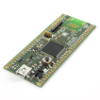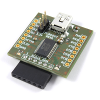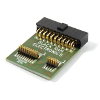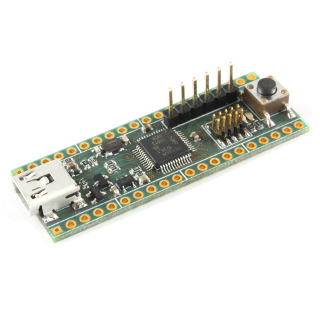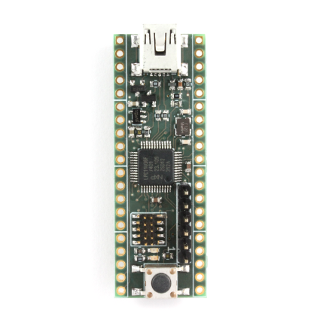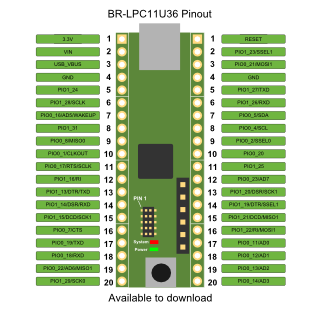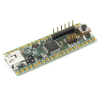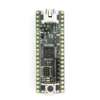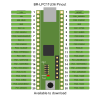
BR-LPC11U36
The 51mm x 18mm BR-LPC11U36 is a very compact product that shares the same PCB as BR-LPC1347. The LPC11U36 from NXP has an ARM Cortex-M0 core and can run at speeds of up to 50MHz, 96kB of Flash and 10kB of RAM.
The LPC11U36 has a built in USB transceiver that can be easily configured to function as any USB device. Additional serial communication interfaces include a USART, two SPI ports and an I2C port. It also features a 10-bit ADC with 8 channels.
The LPC11U36 has a pre-loaded USB bootloader that functions as a USB mass storage device on your PC. This means that programming is as simple as a drag and drop of the firmware file to the drive.
The BR-LPC11U36 board has the same footprint as a 40-pin DIP IC package and includes the following hardware:
- Power LED
- Configurable user LED
- Reset button
- Mini USB connector
- 12MHz oscillator
- Low-dropout voltage regulator
- Comms pin header that is compatible with our FR232RL TTL serial to USB breakout board
To get started check out our Blinky application for the LPC11U36 at GitHub or download here. We also have a tutorial, Introduction to the GNU toolchain for embedded ARM, that will help you get off the ground.
If the BR-LPC11U36 is not right for you then we offer a pair of more powerful boards: The BR-LPC1769 board with Ethernet is an ARM Cortex-M3 running at speeds of up to 120MHz. Additionally, we have the BR-LPC1347, which is the same board as this but with an ARM Cortex-M3 processor.
Features:
- Very compact size
- Direct USB to the processor
- Easy expandability
- Powered from USB
- Pin-for-pin compatible with the ARM Cortex-M3 BR-LPC1347
Possible Applications:
- USB to TTL UART converter
- OLED display driver
- USB to SPI or I2C interface
Microcontroller Features:
- ARM Cortex-M0 processor, running at frequencies of up to 50 MHz
- ARM Cortex-M0 built-in Nested Vectored Interrupt Controller (NVIC)
- System tick timer
- 96 kB on-chip flash program memory
- 4 kB on-chip EEPROM data memory
- 10 kB SRAM data memory
- 16 kB boot ROM
- ROM-based USB drivers. Flash updates via USB supported
- ROM-based 32-bit integer division routines
- Standard JTAG (Joint Test Action Group) test interface
- Serial Wire Debug (SWD)
- High-current source output driver (20 mA) on one pin
- High-current sink driver (20 mA) on true open-drain pins
- Four general purpose counter/timers
- Programmable Windowed WatchDog Timer (WWDT)
- 10-bit ADC with input multiplexing among eight pins
- USB 2.0 full-speed device controller
- USART with fractional baud rate generation
- Two SSP controllers with FIFO and multi-protocol capabilities
- I2C-bus interface supporting the full I2C-bus specification and Fast-mode Plus
- Crystal Oscillator with an operating range of 1 MHz to 25 MHz (system oscillator)
- 12 MHz high-frequency Internal RC oscillator (IRC)
- Internal low-power, low-frequency WatchDog Oscillator (WDO)
- Power profiles residing in boot ROM provide optimized performance
- Four reduced power modes: Sleep, Deep-sleep, Power-down, and Deep power-down
- Processor wake-up from Deep-sleep and Power-down modes
- Processor wake-up from Deep power-down mode using one special function pin
